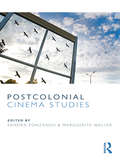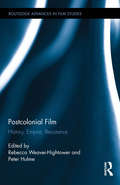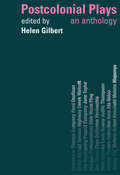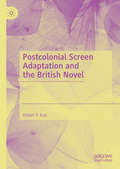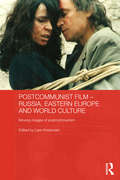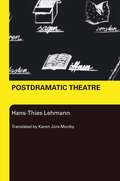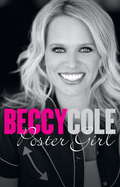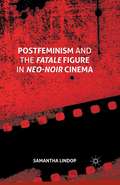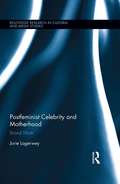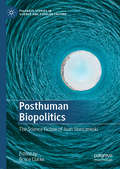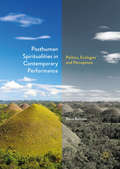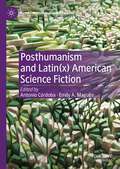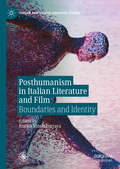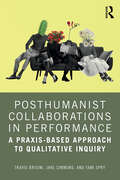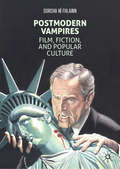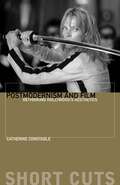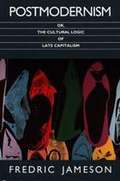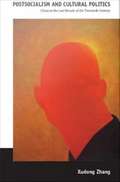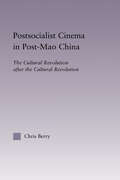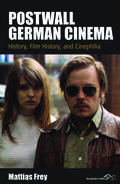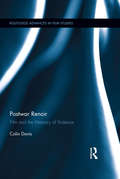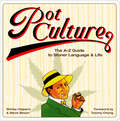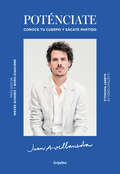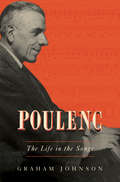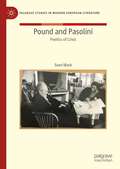- Table View
- List View
Postcolonial Cinema Studies
by Sandra Ponzanesi Marguerite WallerThis collection of essays foregrounds the work of filmmakers in theorizing and comparing postcolonial conditions, recasting debates in both cinema and postcolonial studies. Postcolonial cinema is presented, not as a rigid category, but as an optic through which to address questions of postcolonial historiography, geography, subjectivity, and epistemology. Current circumstances of migration and immigration, militarization, economic exploitation, racial and religious conflict, enactments of citizenship, and cultural self-representation have deep roots in colonial/postcolonial/neocolonial histories. Contributors deeply engage the tense asymmetries bequeathed to the contemporary world by the multiple,diverse, and overlapping histories of European, Soviet, U.S., and multi-national imperial ventures. With interdisciplinary expertise, they discover and explore the conceptual temporalities and spatialities of postcoloniality, with an emphasis on the politics of form, the ‘postcolonial aesthetics’ through which filmmakers challenge themselves and their viewers to move beyond national and imperial imaginaries. Contributors include: Jude G. Akudinobi, Kanika Batra, Ruth Ben-Ghiat, Shohini Chaudhuri, Julie F. Codell, Sabine Doran, Hamish Ford, Claudia Hoffmann, Anikó Imre, Priya Jaikumar, Mariam B. Lam, Paulo de Medeiros, Sandra Ponzanesi, Richard Rice, Mireille Rosello and Marguerite Waller.
Postcolonial Film: History, Empire, Resistance (Routledge Advances in Film Studies #30)
by Peter Hulme Rebecca Weaver-HightowerPostcolonial Film: History, Empire, Resistance examines films of the later twentieth and early twenty-first centuries from postcolonial countries around the globe. In the mid twentieth century, the political reality of resistance and decolonization lead to the creation of dozens of new states, forming a backdrop to films of that period. Towards the century’s end and at the dawn of the new millennium, film continues to form a site for interrogating colonization and decolonization, though against a backdrop that is now more neo-colonial than colonial and more culturally imperial than imperial. This volume explores how individual films emerged from and commented on postcolonial spaces and the building and breaking down of the European empire. Each chapter is a case study examining how a particular film from a postcolonial nation emerges from and reflects that nation’s unique postcolonial situation. This analysis of one nation’s struggle with its coloniality allows each essay to investigate just what it means to be postcolonial.
Postcolonial Plays: An Anthology
by Helen GilbertThis collection of contemporary postcolonial plays demonstrates the extraordinary vitality of a body of work that is currently influencing the shape of contemporary world theatre. This anthology encompasses both internationally admired 'classics' and previously unpublished texts, all dealing with imperialism and its aftermath. It includes work from Canada, the Carribean, South and West Africa, Southeast Asia, India, New Zealand and Australia. A general introduction outlines major themes in postcolonial plays. Introductions to individual plays include information on authors as well as overviews of cultural contexts, major ideas and performance history.Dramaturgical techniques in the plays draw on Western theatre as well as local performance traditions and include agit-prop dialogue, musical routines, storytelling, ritual incantation, epic narration, dance, multimedia presentation and puppetry. The plays dramatize diverse issues, such as:*globalization* political corruption* race and class relations*slavery*gender and sexuality*media representation*nationalism
Postcolonial Screen Adaptation and the British Novel
by Vivian Y. KaoThis book brings film adaptation of literature to bear on the question of how nineteenth-century imperial ideologies of progress continue to inform power inequalities in a global capitalist age. Not simply the promotion of general betterment for all, improvement in the British colonial context licensed a superior “master race” to “uplift” its colonized populations—morally, socially, and economically. This book argues that, on the one hand, film adaptations of nineteenth-century novels reveal the arrogance and coercive intentions that underpin contemporary notions of development, humanitarianism, and modernity—improvement’s post-Victorian guises. On the other hand, the book also argues that the films use their nineteenth-century source texts to criticize these same legacies of imperialism. By bringing together film adaptation, postcolonial theory, and literary studies, the book demonstrates that adaptation, as both method and cultural product, provides a way to engage with the baggage of ideological heritage in our contemporary global media environment.
Postcommunist Film - Russia, Eastern Europe and World Culture: Moving Images of Postcommunism (Routledge Contemporary Russia and Eastern Europe Series)
by Lars KristensenA post-communist condition has arisen from the fall of the Berlin Wall and later the Soviet Empire: this book looks at how this condition has manifested itself globally in the production of post-communist film. It argues post-communism is a shared experience on a geopolitical level, unlimited by national state borders, and examines post-communist cross culturalism and global totalitarianism within film. The book examines different national cinemas and dissimilar cinematic modes - from Russian blockbuster cinema to Chinese independent cinema; from Serbian city films to revolutionary films of Mozambique - all formulated as within the postcommunist condition. It considers the postcommunist film in terms of transnational and World cinema. It covers a wide range of films from small and independent filmmaking to mainstream, popular cinema, and explains post-communist signifiers as manifested in visual culture both inside and outside former, and current, communist countries.
Postdramatic Theatre
by Hans-Thies LehmannNewly adapted for the Anglophone reader, this is an excellent translation of Hans-Thies Lehmann’s groundbreaking study of the new theatre forms that have developed since the late 1960s, which has become a key reference point in international discussions of contemporary theatre. In looking at the developments since the late 1960s, Lehmann considers them in relation to dramatic theory and theatre history, as an inventive response to the emergence of new technologies, and as an historical shift from a text-based culture to a new media age of image and sound. Engaging with theoreticians of 'drama' from Aristotle and Brecht, to Barthes and Schechner, the book analyzes the work of recent experimental theatre practitioners such as Robert Wilson, Tadeusz Kantor, Heiner Müller, the Wooster Group, Needcompany and Societas Raffaello Sanzio. Illustrated by a wealth of practical examples, and with an introduction by Karen Jürs-Munby providing useful theoretical and artistic contexts for the book, Postdramatic Theatre is an historical survey expertly combined with a unique theoretical approach which guides the reader through this new theatre landscape.
Poster Girl
by Beccy ColeBeccy Cole's inspirational memoir from the heart of Australian country music.Beccy Cole has country music in her blood. Daughter of a country music star, Carole Sturtzel, she is one of the most popular country singer-songwriters in Australia today. This is the story of her life - in her own words.At fourteen, Beccy was performing in her mother's group, Wild Oats. By her late teens, Beccy had teamed up with the Dead Ringer Band - Kasey Chambers' family band - and had attracted the attention of the country music world by winning the Star Maker quest: the same award that started the careers of Keith Urban, Lee Kernaghan, James Blundell and Gina Jeffreys. It was just the first of many awards and accolades for this multitalented woman with a big heart.With refreshing candour, Beccy shares her story: leaving everything she knew to pursue her dream, making a name for herself with her own band; her marriage and motherhood; her subsequent divorce, becoming a single mother and maintaining the nurturing love of family. Performing for the Australian troops in Afghanistan. Coming out, and what it has meant for her and her fans. Taking control of her own life - and finding love.Heartfelt and honest, Poster Girl is the inspirational memoir of a strong woman who epitomises the authentic spirit of country music, and of Australia.
Postfeminism and the Fatale Figure in Neo-Noir Cinema
by Samantha LindopThis book is a thought-provoking study that expands on film scholarship on noir and feminist scholarship on postfeminism, subjectivity, and representation to provide an inclusive, sophisticated, and up-to-date analysis of the femme fatale , fille fatale , and homme fatal from the classic era through to recent postmillennial neo-noir .
Postfeminist Celebrity and Motherhood: Brand Mom (Routledge Research in Cultural and Media Studies)
by Jorie LagerweyThis book analyzes the intersections of celebrity, self-branding, and "mommy" culture. It examines how images of celebrity moms playing versions of themselves on reality television, social media, gossip sites, and self-branded retail outlets negotiate the complex demands of postfeminism and the current fashion for heroic, labor intensive parenting. The cultural regime of "new momism" insists that women be expert in both affective and economic labor, producing loving families, self-brands based on emotional connections with consumers, and lucrative saleable commodities. Successfully creating all three: a self-brand, a style of motherhood, and lucrative product sales, is represented as the only path to fulfilled adult womanhood and citizenship. The book interrogates the classed and racialized privilege inherent in those success stories and looks for ways that the versions of branded motherhood represented as failures might open a space for a more inclusive emergent feminism.
Posthuman Biopolitics: The Science Fiction of Joan Slonczewski (Palgrave Studies in Science and Popular Culture)
by Bruce ClarkeThis volume presents the first collection of essays dedicated to the science fiction of microbiologist Joan Slonczewski. Posthuman Biopolitics consolidates the scholarly literature on Slonczewski’s fiction and demonstrates fruitful lines of engagement for the critical, cultural, and theoretical treatment of her characters, plots, and storyworlds. Her novels treat feminism in relation to scientific practice, resistance to domination, pacifism versus militarism, the extension of human rights to nonhuman and posthuman actors, biopolitics and posthuman ethics, and symbiosis and communication across planetary scales. Posthuman Biopolitics explores the breadth and depth of Joan Slonczewski’s vision, uncovering the reflective ethical practice that informs her science fiction.
Posthuman Spiritualities in Contemporary Performance: Politics, Ecologies and Perceptions
by Silvia BattistaThis book provides an interpretative analysis of the notion of spirituality through the lens of contemporary performance and posthuman theories. The book examines five performance/artworks: The Artist is Present (2010) by Marina Abramović; The Deer Shelter Skyscape (2007) by James Turrell; CAT (1998) by Ansuman Biswas; Journey to the Lower World by Marcus Coates (2004); and the work with pollen by Wolfgang Laib. Through the analysis of these works the notion of spirituality is grounded in materiality and embodiment allowing the conceptual juxtaposition of spirit and matter to introduce the paradoxical as the guiding thread of the narrative of the book. Here, the human is interrogated and negotiated with/within a plurality of other living organisms, intangible existences and micro and macrocosmic ecologies. Silence, meditation, shamanic journeys, reciprocal gazing, restraint, and contemplation are analyzed as technologies used to manipulate perception and adventure into the multilayered condition of matter.
Posthumanism and Latin (Studies in Global Science Fiction)
by Emily A. Maguire Antonio CórdobaThis volume explores how Latin American and Latinx creators have engaged science fiction to explore posthumanist thought. Contributors reflect on how Latin American and Latinx speculative art conceptualizes the operations of other, non-human forms of agency, and engages in environmentalist theory in ways that are estranging and open to new forms of species companionship. Essays cover literature, film, TV shows, and music, grouped in three sections: “Posthumanist Subjects” examines Latin(x) American iterations of some of the most common figurations of the posthuman, such as the cyborg and virtual environments and selves; “Slow Violence and Environmental Threats” understands that posthumanist meditations in the hemisphere take place in a material and cultural context shaped by the catastrophic destruction of the environment; the chapters in “Posthumanist Others” shows how the reimagination of the self and the world that posthumanism offers may be an opportunity to break the hold that oppressive systems have over the ways in which societies are constructed and governed.
Posthumanism in Italian Literature and Film: Boundaries and Identity (Italian and Italian American Studies)
by Enrica Maria FerraraAs humans re-negotiate their boundaries with the nonhuman world of animals,inanimate entities and technological artefacts, new identities are formed and anew epistemological and ethical approach to reality is needed. Through twelvethought-provoking, scholarly essays, this volume analyzes works by a range ofmodern and contemporary Italian authors, from Giacomo Leopardi to ElenaFerrante, who have captured the shift from anthropocentrism and postmodernismto posthumanism. Indeed, this is the first academic volume investigating narrativeconfigurations of posthuman identity in Italian literature and film.
Posthumanist Collaborations in Performance: A Praxis-based Approach to Qualitative Inquiry
by Tami Spry Jake Simmons Travis BrisiniPosthumanist Collaborations in Performance presents a novel approach for readers to engage with new materialist performance as a method of qualitative inquiry and as a means of combating the anthropocentric loneliness of modern life.It offers a theoretical and practical examination of how we are fundamentally entangled with a more-than-human world through practices the authors call “naturecultural performances.” The book features a collaborative body of arts-based research by three scholars working at the intersections of performance studies, new materialism, environmental studies, and qualitative inquiry. The result is an interdisciplinary body of theoretical scholarship, including a wide array of landscapes, plants, animals, minerals, and other more-than-human agencies. The book also presents practical examples and case studies of naturecultural performances, showcasing the diverse ways in which the concept of “natureculture” can be applied in research and creative practice.This book will be of interest to faculty, graduate and undergraduate students, performance practitioners, and anyone else interested in exploring or creating work based on their own fundamental relationships with the more-than-human world.
Postmodern Vampires: Film, Fiction, and Popular Culture
by Sorcha Ní FhlainnPostmodern Vampires: Film, Fiction, and Popular Culture is the first major study to focus on American cultural history from the vampire’s point of view. Beginning in 1968, Ní Fhlainn argues that vampires move from the margins to the centre of popular culture as representatives of the anxieties and aspirations of their age. Mapping their literary and screen evolution on to the American Presidency, from Richard Nixon to Donald Trump, this essential critical study chronicles the vampire’s blood-ties to distinct socio-political movements and cultural decades in the late twentieth and early twenty-first centuries. Through case studies of key texts, including Interview with the Vampire, The Lost Boys, Blade, Twilight, Let Me In, True Blood and numerous adaptations of Dracula, this book reveals how vampires continue to be exemplary barometers of political and historical change in the American imagination. It is essential reading for scholars and students in Gothic and Horror Studies, Film Studies, and American Studies, and for anyone interested in the articulate undead.
Postmodernism and Film: Rethinking Hollywood's Aesthestics (Short Cuts)
by Catherine ConstableThis volume focuses on postmodern film aesthetics and contemporary challenges to the aesthetic paradigms dominating analyses of Hollywood cinema. It explores conceptions of the classical, modernist, post-classical/new Hollywood, and their construction as linear history of style in which postmodernism forms a debatable final act. This history is challenged by using Jean-François Lyotard's non-linear conception of postmodernism in order to view postmodern aesthetics as a paradigm that can occur across the history of Hollywood. This study also explores 'nihilistic' theorists of the postmodern, Jean Baudrillard and Frederic Jameson, and 'affirmative' theorists, notably Linda Hutcheon, charting the ways in which the latter provide the means to conceptualize nuanced and positive variants of postmodern aesthetics and deploying them in the analysis of Hollywood films, including Bombshell, Sherlock Junior, and Kill Bill.
Postmodernism, or, The Cultural Logic of Late Capitalism
by Fredric JamesonNow in paperback, Fredric Jameson's most wide-ranging work seeks to crystallize a definition of "postmodernism." Jameson's inquiry looks at the postmodern across a wide landscape, from "high" art to "low" from market ideology to architecture, from painting to "punk" film, from video art to literature.
Postsocialism and Cultural Politics: China in the Last Decade of the Twentieth Century
by Xudong ZhangIn Postsocialism and Cultural Politics, Xudong Zhang offers a critical analysis of China's "long 1990s," the tumultuous years between the 1989 Tiananmen Square crackdown and China's entry into the World Trade Organization in 2001. The 1990s were marked by Deng Xiaoping's market-oriented reforms, the Taiwan missile crisis, the Asian financial crisis, and the end of British colonial rule of Hong Kong. Considering developments including the state's cultivation of a market economy, the aggressive neoliberalism that accompanied that effort, the rise of a middle class and a consumer culture, and China's entry into the world economy, Zhang argues that Chinese socialism is not over. Rather it survives as postsocialism, which is articulated through the discourses of postmodernism and nationalism and through the co-existence of multiple modes of production and socio-cultural norms. Highlighting China's uniqueness, as well as the implications of its recent experiences for the wider world, Zhang suggests that Chinese postsocialism illuminates previously obscure aspects of the global shift from modernity to postmodernity. Zhang examines the reactions of intellectuals, authors, and filmmakers to the cultural and political conflicts in China during the 1990s. He offers a nuanced assessment of the changing divisions and allegiances within the intellectual landscape, and he analyzes the postsocialist realism of the era through readings of Mo Yan's fiction and the films of Zhang Yimou. With Postsocialism and Cultural Politics, Zhang applies the same keen insight to China's long 1990s that he brought to bear on the 1980s in Chinese Modernism in the Era of Reforms.
Postsocialist Cinema in Post-Mao China: The Cultural Revolution after the Cultural Revolution (East Asia: History, Politics, Sociology and Culture)
by Chris BerryThis book argues that the fundamental shift in Chinese Cinema away from Socialism and towards Post-Socialism can be located earlier than the emergence of the "Fifth Generation" in the mid-eighties when it is usually assumed to have occured. By close analysis of films from the 1949-1976 Maoist era in comparison with 1976-81 films representing the Cultural Revolution, it demonstrates that the latter already breaks away from Socialism.
Postwall German Cinema
by Mattias FreySince the fall of the Berlin Wall, there has been a proliferation of German historical films. These productions have earned prestigious awards and succeeded at box offices both at home and abroad, where they count among the most popular German films of all time. Recently, however, the country's cinematic take on history has seen a significant new development: the radical style, content, and politics of the New German Cinema. With in-depth analyses of the major trends and films, this book represents a comprehensive assessment of the historical film in today's Germany. Challenging previous paradigms, it takes account of a postwall cinema that complexly engages with various historiographical forms and, above all, with film history itself.
Postwar Renoir: Film and the Memory of Violence (Routledge Advances in Film Studies)
by Colin DavisThis book re-assesses director Jean Renoir’s work between his departure from France in 1940 and his death in 1979, and contributes to the debate over how the medium of film registers the impact of trauma. The 1930s ended in catastrophe for both for Renoir and for France: La Règle du jeu was a critical and commercial disaster on its release in July 1939 and in 1940 France was occupied by Germany. Even so, Renoir continued to innovate and experiment with his post-war work, yet the thirteen films he made between 1941 and 1969, constituting nearly half of his work in sound cinema, have been sorely neglected in the study of his work. With detailed readings of the these films and four novels produced by Renoir in his last four decades, Davis explores the direct and indirect ways in which film, and Renoir’s films in particular, depict the aftermath of violence.
Pot Culture: The A–Z Guide to Stoner Language & Life
by Steve Bloom Shirley Halperin“Essentially an encyclopedia of pot, filled with such top 10 lists as ‘best stoner movies’ . . . plus a ‘pot-parazzi’ section with celebrities sneaking a toke.” —BillboardDo you know the difference between burning one and Burning Man? Does using the name Marley as an adjective make total sense to you? Do you chuckle to yourself when the clock strikes 4:20? Are you convinced that the movie Dazed and Confused deserved an Oscar? If you answered “Dude!” to any of these questions, then Pot Culture is the book you’ve been waiting for. For those in the know, it’s the stoner bible. For novices, it’s Pot 101. Either way, Pot Culture encapsulates the history, lifestyle, and language of a subculture that, with every generation, is constantly redefining itself. From exhaustive lists of stoner-friendly movies, music, and television shows to detailed explanations of various stoner tools to celebrity-authored how-tos and an A-Z compendium of slang words and terms, it’s the ultimate encyclopedia of pot. Written by former High Times editors Shirley Halperin (now a senior writer at Entertainment Weekly and a TV talking head) and Steve Bloom (publisher of CelebStoner.com), and featuring contributions by a host of celebrity stoners, including Melissa Etheridge, Maroon 5’s Adam Levine, Redman, Steve-O, and America’s Next Top Model’s Adrianne Curry, Pot Culture provides the answers to everything you ever wanted to know about pot but were too stoned to ask.“This is a fun book that every toker should get their sticky green fingers on. Clever and informative . . . Great book and a must-buy for all us loadies.” —Blogcritics
Poténciate: Conoce tu cuerpo y sácate partido
by Juan AvellanedaJuan Avellaneda, diseñador, icono e influencer de la moda española, y considerado uno de los hombres más elegantes de nuestro país, nos ofrece sus consejos de estilo para sacar el máximo partido de nosotros mismos. «Reconozco que yo también he tenido miedo: miedo al qué dirán, a si me aceptarán... Hasta que aprendí a dejar de lado los prejuicios y aceptar mi cuerpo tal como es. Con este libro, quiero ayudarte a proyectar la mejor imagen de ti mismo, la que habla realmente de ti, gracias a todo lo que he aprendido a lo largo de mi carrera como diseñador: qué estampados o cortes te favorecen más, cuáles son los colores que realzan mejor tu personalidad o cómo puedes potenciar aún más esa parte que tanto te gusta de ti. Ya es hora de reconciliarte con tu silueta y tu aspecto, y de descubrir tu estilo personal, porque lo que más importa es que te sientas bien tal como eres.» Ahora más que nunca toca sacar lo mejor de ti.
Poulenc: The Life In The Songs
by Graham JohnsonOne of the greatest modernist composers comes alive in this illuminating biography, a must-have for musicians and music-lovers alike. Francis Poulenc (1899–1963) is widely acknowledged as one of the twentieth century’s most significant masters of vocal music —solo, choral, and operatic— quite apart from his achievements in instrumental spheres. But what it cost him, and the determined bravery it took for his unusual talent to thrive, has always been underestimated. In this seminal biography, which will serve as the definitive guide to the songs, acclaimed collaborative pianist Graham Johnson shows that it is in Poulenc’s extraordinary songs, and seeing how they fit into his life —which included crippling guilt on account of his sexuality— that we discover Poulenc heart and soul. With Jeremy Sams’s vibrant new song translations, the first in over forty years, and the insight that comes from a lifetime of performing this music, Johnson provides an essential volume for singers, pianists, listeners, and readers interested in the artistic milieu of modernism in the first half of the twentieth century.
Pound and Pasolini: Poetics of Crisis (Palgrave Studies in Modern European Literature)
by Sean MarkIn October 1967, Pier Paolo Pasolini travelled to Venice to interview Ezra Pound for broadcast on national television. One a lifelong Marxist, the other a former propagandist for the Fascist regime, their encounter was billed as a clash of opposites. But what do these poets share? And what can they tell us about the poetics and politics of the twentieth century? This book reads one by way of the other, aligning their engagement with different temporalities and traditions, polities and geographies, languages and forms, evoked as utopian alternatives to the cultural and political crises of capitalist modernity. Part literary history, part comparative study, it offers a new and provocative perspective on these poets and the critical debates around them – in particular, on Pound’s Italian years and Pasolini’s use of Pound in his work. Their connection helps to understand the implications and legacies of their work today.
